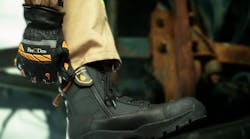Now, a movement is under way to test firefighters and catch the disease in its earliest, most treatable phase -- and to find ways to keep firefighters from breathing in the particles that cause the problems.
This month, Troy firefighters became the first professional department in the nation to undergo a new screening method for bladder cancer. Volunteers at the West Sand Lake Department also have taken the test using a simple new device that gives an answer within half an hour.
"There hasn't been any easy way to do the screening for bladder cancer until now," said Dr. Robert M. Schlesinger, who conducted the testing among city firefighters this week.
Many firefighters taking the test said they were surprised to learn about their risks.
"I had no idea there was an elevated risk for bladder cancer during fires," said Troy Fire Capt. Jack Schneider. "You naturally think about lung cancer and heart disease but not bladder cancer. There are a lot of things to worry about, but that's not foremost on my mind."
The breathing apparatus that firefighters wear is only good for 20 minutes, so many firefighters remove their masks until using them is urgent. Once a fire is out, they tend to take them off.
"You're hot, you're sweating. Wearing it is to some people a pain in the neck," Schneider said. "A lot of people think the fire is out, relax your level of protection, but that's not true."
Schenectady Fire Chief Robert Farstad had not heard about the testing, but said he wanted to know more.
"We'd always be interested in the health and safety of our members," he said.
Fangchao Ma, an assistant scientist at the University of Miami, conducted a study of 35,777 men who became Florida firefighters between 1972 and 1999. He found both the incidence of bladder cancer and mortality rates from the disease were higher than among the general populace.
"The incidence of bladder cancer was significantly elevated," he said.
Firefighters were 1.3 times more likely to develop bladder cancer, he said, and those hired between 1972 and 1976 were 50 percent more likely to die of it than the average citizen. Since cancer takes years or even decades to develop, he said, those hired more recently may not yet show signs of malignancy.
"I'm quite confident that the bladder cancer was elevated in firefighters, so more attention should be paid," Ma said.
Unlike other cancers, which often have genetic roots, bladder cancer largely stems from environmental causes.
Tom LaBelle, executive director of the New York State Association of Fire Chiefs, said the organization supports regular testing of firefighters.
"It's certainly morally the correct thing to do," he said.
And he said firefighters are becoming more aware of the hazards in the air after a blaze is out.
"There is growing recognition in the industry that more needs to be done in that time frame and during investigations as well," he said. "It's nice to see the fire service become more long-term health-conscious. We need to look deeper at some of the long-term illnesses that stem from firefighting."
Fire investigators also are at greater risk for bladder cancer and often don't wear protective gear while they search through the debris, stirring up potential carcinogens.
"They are in overalls and hard hats," said Troy Firefighter Richard Cellucci.
More than 70 Troy firefighters took the urine test, which uses a new device called an NMP22 Bladderchek, manufactured by Newton, Mass-based Matritech Inc. The firm, for which Schlesinger works as a consultant, donated the devices for the testing.
"The way this technology works is there is a material specific to the nucleus of every cell. It is immunologically specific for each cell," Schlesinger said. "When the cell dies, this material comes out of the cell."
The Matritech device detects the material -- called NMP22 -- from bladder cells found in urine. The urine is also tested for blood, another potential warning sign.
Schlesinger, who lives in West Sand Lake, works with the New England Sinai Hospital and Rehabilitation Center in Boston.
Firefighters who tested positive are told to see their doctor for further tests, and they agreed to inform Schlesinger of any findings.
Bladder cancer is the sixth-most-common type, with 50,000 new cases and 12,000 deaths each year, Schlesinger said.
"What we're trying to do with the testing in Rensselaer County is to increase awareness of their risks," said Stephen D. Chubb, founder, chairman and CEO of Matritech. "It's a pilot program in which we have donated these tests."
The firm received approval for a lab-based version of the testing device in the 1990s, and the Food and Drug Administration approved use for individuals last year.
The International Association of Fire Fighters supports annual physicals to test for bladder cancer as well as other ailments that regularly affect its members, said Richard M. Duffy, assistant to the union's general president for occupational safety, health and medicine. It takes no position on the Matritech test versus other forms of screening.





